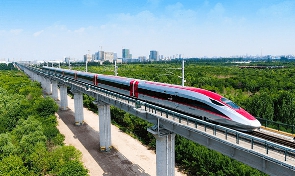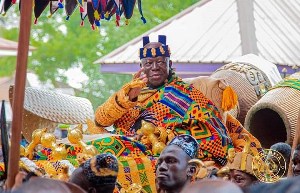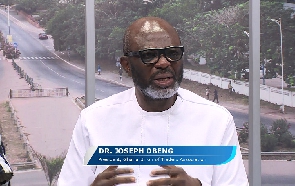Opinions of Monday, 16 October 2023
Columnist: Alexander Ayertey Odonkor
Ten years on: What does China’s BRI mean to the Global South?
The year 2023 marks 10 years since Chinese President Xi Jinping unveiled the Silk Road Economic Belt and the 21st Century Maritime Silk Road, collectively known as the Belt and Road Initiative (BRI).
Over the past decade, the BRI has gained worldwide traction and garnered overwhelming support from the international community. Though the China-led effort focused on Asia, Europe, and Africa, providing common economic prosperity for countries along the ancient Silk Road trade route, the project is open to all countries.
So far, China has signed BRI cooperation with more than 150 countries and over 30 international organizations. Overall, the BRI has established more than 3,000 projects and galvanised almost US$ 1 trillion of investment – built numerous livelihood projects, developed massive infrastructure facilities, and achieved milestones of cooperation.
Rooted in history but oriented towards the future, the BRI, which aims to improve connectivity and enhance cooperation on a transcontinental scale has become a major development opportunity, not only for a select few but the entire world.
A World Bank Report (2019) shows that if fully implemented, the BRI transport projects could foster trade between 1.7 and 6.2 percent for the world, increasing global real income by 0.7 to 2.9 percent – lifting 7.6 million people from extreme poverty (people earning less than US$1.90 a day) and 32 million people from moderate poverty (people earning less than US$3.20 a day).
To add more, another study (2019) from the Centre for Economics and Business Research (Cebr), sponsored by the Charted Institute of Building (CIOB), estimates that the BRI is likely to boost world GDP by 2040 by US$7.1 trillion per year – stimulating growth in all of the world’s ten (10) regions – as many as 56 countries are forecast to have their annual GDP in 2040 bolstered by more than US$10 billion as a result of BRI.
For developing countries, which typically, face structural impediments to sustainable development, mostly left with minimal or no avenues to secure essential resources to tackle daunting socioeconomic challenges, the BRI has become a fortress – by expanding connectivity and facilitating healthy cooperation, the China-led effort opens up developing nations for international trade and strengthens cooperation in key sectors, including agriculture, energy and information and communications technology (ICT), fostering innovation, productivity and higher income – this enhances developing countries’ capacities for growth, providing new opportunities to achieve national development goals.
Considering the BRI’s invaluable contributions, especially to developing countries, it is certainly not surprising that the project has garnered unswerving support from the Global South. Characterised by huge infrastructure footprints including the China-Pakistan Economic Corridor (CPEC), China-Laos Railway, Jakarta-Bandung High-Speed Railway, and the Colombo Port City, with several large-scale projects yet to be completed, the BRI is increasingly tackling structural deficiencies in the Global South across various industries such as energy, transport, agriculture, and ICT – driving economic transformation and building robust economies.
In Africa, home to the world’s largest number of least developed countries (LDCs), the BRI, has gained massive support on the continent – growing by leaps and bounds. In a recent event, on September 8, which marked a significant milestone in the Sino-Africa cooperation, the African Union (AU) and the Chinese Mission to the AU pledged to further deepen cooperation under the BRI, to achieve common economic prosperity – For people domiciled in countries across the African continent, recent efforts by the two parties to further strengthen cooperation under the China-led infrastructure development project is definitely far from out of the blue.
For decades, Africa has been characterised by complex and formidable structural challenges, a hindrance to sustainable growth and development. However, since the introduction of the BRI to the continent, the project has injected new impetus into various industries – steering African countries along a sustained path of growth, economic transformation, and resilience.
The BRI is increasingly central to national and concerted actions dedicated to tackling decades-long challenges and structural deficiencies, widely known as the reasons for low GDP growth and slow pace of development – this is increasingly evident in key sectors in Africa, including transport.
Built primarily to plunder minerals and agricultural resources during the colonial era, Africa’s transport network, including roads and railways, is linked to mines, plantations, and other key sites of exploitation which are connected to ports, with the ultimate goal of transporting resources to destinations far away from the continent – serving the colonizers’ interest rather than to provide general connectivity within countries on the continent.
However, with the introduction of the BRI, which strengthens cooperation and promotes hard and soft infrastructure development including digital connectivity, harmonization of regulations and standards, customs cooperation, and people-to-people exchanges, the decades-long labeling of Africa as the region with fragmented roads, poorly maintained railways and low-density transport network with respect to population, a key constraint of intra-Africa trade, is increasingly becoming a distant memory.
In Nigeria, the continent’s largest economy and most populous country, reaps increasing social and economic gains from several massive transport infrastructure facilities under the BRI.
To mention a few, the China-built Lagos-Kano standard gauge project, the first standard gauge railway in Nigeria and West Africa has significantly improved mobility – the Abuja-Kaduna Railway which is the first segment of the project has safely transported nearly 6.5 million passengers since it commenced operation in 2016.
To further enhance the transport sector’s capacity – in January 2023 Nigeria witnessed the completion and opening of major projects under the BRI, including the first phase of the Lagos Rail Mass Transit Blue Line project and the Lekki deep-water port, the largest deep-water port in West Africa – constructed by China Harbour Engineering Company Limited, the facility is expected to generate about US$360 billion of economic value and create 170,000 jobs – as it enhances Nigeria’s capacity to process export and import.
The wind of Change is blowing across countries on the African continent – there are huge footprints of BRI projects at various phases of construction. From sub-Saharan Africa to North Africa, there are mega BRI infrastructure facilities including industrial parks, the Mombasa-Nairobi Standard Gauge Railway, Ethiopia-Djibouti railway, and Algeria’s El Hamdania Port, which will be the country’s largest and first deep-water port and Africa’s second deep-water port once completed.
Collectively, these BRI facilities have enhanced economic integration – linked Africa’s major economies to small landlocked countries and upgraded the region’s manufacturing and value-addition capacities, creating an enabling environment for the African Continental Free Trade Area (AfCFTA) to thrive.
At the third Belt and Road Forum for International Cooperation, expected to be held on October 17-18, the platform presents an important opportunity for African countries to engage the rest of the world on BRI cooperation, share experiences, and identify new areas for cooperation to drive growth.













